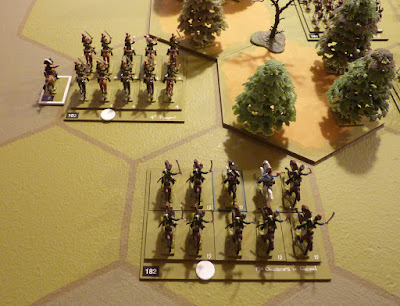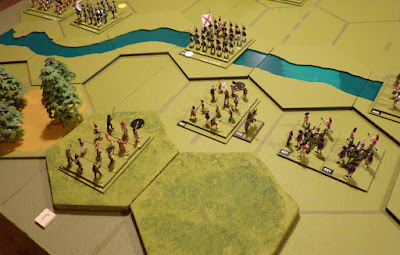Peninsular War Zoom game took place yesterday - I was the host and the French commander (Marshal Victor), trying to capture the crossings over the River Mezquino, defended by a force from the Spanish Army of the Centre, commanded by Stryker (Conde de Belvedere).
The Spaniards had a hybrid force, including a contingent of irregulars under the command of the (little-known) Don Pedro de Gentusa. The French had Sebastiani's (French) Division and Leval's (German) Division, plus an attachment of cavalry from Latour Maubourg's reserve.
Commands & Colors rules, with my Ramekin modifications. I'll append the player instructions and scenario notes at the end of this post (if I remember). 10 Victory Points for victory - the French had bonus VPs available for capture of town hexes, bridge and fords at the town of Santiago.
My sincere thanks to Stryker for an enjoyable game. I said I'd include part of the scenario notes, so here they are:
French Force (Marshal Victor)
From IV Corps
Division Leval
2e Nassau (2 bns), Régt de Frankfort (1), 4e Badois (2), 4e Hessois "Gross und Erbprinz" (2), 2 bns converged voltigeurs
Division Sebastiani
15e Ligne (2 bns), 66e Ligne (2), 70e Ligne (1), 82e Ligne (2), 86e Ligne (2), 2 bns converged voltigeurs
2 cos Art à Pied
Cavalry
From Division La Tour-Maubourg (from Reserve)
4e Dragons, 26e Dragons + 15 Chasseurs à Cheval (attached)
Total: 16 line bns [LN], 4 light bns [LT], 2 dragoons [HC], 1 light cavalry [LC], 2 foot batteries [FA]. (approx 15000 infantry, 1000 cavalry, 16 guns)
Spanish Army (advance guard under MdC Belvedere)
Division Del Parque
Africa (2 bns), Reina (2), combined grenadiers (1 - Africa, Reina), Ligero de Barbastro (1), Provinciales de Cordoba (1), Provinciales de Granada (1)
Division Portago
Burgos (2 bns), Irlanda (1), Guardias Wallonas (1), Ligero de Cataluña (1), Ligero de Campo Mayor (1)
2 foot batteries
Cavalry (Col Ramos da Silva)
Husares de Maria Luisa, Voluntarios de España, Lanceros de Carmona
Attached irregulars (Don Pedro de Gentusa)
4 "battalions" of irregular infantry raised by the Junta de Aragon.
Total: 7 line bns [LN], 1 bn grenadiers [GR], 1 bn foot guards [FG], 3 light bns [LT], 2 bns Provincial Militia [MI], 2 light cavalry {LC], 1 lancers [LA], 2 foot batteries [FA], 4 small units of irregulars [GU].
(approx 10400 infantry, 1000 cavalry, 12 guns + 1600 irregulars)
Scenario Narrative
It is April 1809. A number of well-known events from the Peninsular War have not happened, and as a result a French army is advancing from Madrid towards the Spanish Army of the Centre, which is commanded by Marcial de Campo Gregorio Garcia de Cuesta, and is camped in the region around Cuenca. Cuesta is 68 years old, and in poor health, and is in any case well-known for his difficulty in making decisions, and for concocting grandiose strategies which waste time and achieve little.
His army is in good shape, but his senior officers are mostly inexperienced and lacking in talent. The army is brave and well equipped, but many of the troops are new recruits, understanding of battlefield drill is generally weak. The particular weakness of this army is an inability to manoeuvre in action. Thus they will fight well enough in a defensive position, but are at a disadvantage if they are required to attack, or maintain any kind of effective fire while advancing. The Provincial Militia units are the worst, and the irregular "guerrilleros" provide by the local Junta are unreliable and usually incapable of any action more formal than a simple ambush.
[One odd quality that the Spanish soldiers have is that they do not expect to be victorious, but if defeated they will retreat from the field and be ready to fight again within a week or so. The French will constantly be embarrassed by this resilience. They are used to defeated enemies committing to a formal surrender, not dusting themselves off for the next round.]
The French army is under the command of Marshal Claude Victor-Perrin. On the road to Cuenca, there is a crossing over the Rio Mezquino at the small town of Santiago Martir. The river is, for the most part, deep with steep banks, but at Santiago the road to Cuenca crosses the river over a good stone bridge - the only one for some leagues in either direction - and a couple of fords, and the river may be crossed for a mile or so on either side of the town (though not by artillery or wagons). The French are capable of constructing temporary bridges, but it will save them time if they can secure the crossings at Santiago.
Keen to secure the bridge before the Spaniards can destroy it, Marshal Victor himself leads an advanced guard - he has good quality German troops from the Confederation of the Rhine and veteran French troops of Sebastiani's IV Corps, and he has a small contingent of cavalry. His army is confident, since they are superior in most respects to the Spaniards, and their commanders are incomparably better. [The French despise the Spaniards, the Spaniards hate the French.]
Acting with uncharacteristic haste, Cuesta sends the Conde de Belvedere with a vanguard to seize Santiago before the French can get there, and to protect the river crossing, and so, when Victor arrives, he is surprised to find the little town and the hills beside it are already occupied by the enemy. Belvedere's force has been augmented by the addition of about 1600 irregular troops under the command of the little-known Don Pedro de Gentusa, a local land-owner - these irregular soldiers are fiercely patriotic, but erratic in performance - many of the "officers" being priests or community leaders.





























The Spanish lads made a brave fight of it, the irregulars and Guard in particular. Next time though I’m hoping for a British army!
ReplyDeleteI'm sure something of the sort will be possible! Thank you for playing.
DeleteThe Spaniards did better than I thought they would I must confess. Looks like a great game!
ReplyDeleteThere's always a satisfying unpredictability about the Spanish army!
DeleteLovely game Tony. Some beautiful photos of the variety of figures/units. The Lanceros de Carmona are one of many interesting, novel units in the Spanish army. I managed to get a copy of José Maria Bueno Carrera's "Uniformes espanoles de la Guerra de la Independencia 1808-1814" a little while ago. It is packed with images and details of the great mix of units and uniforms, particularly amongst the volunteers and provincial militia. I used it to have a go at representing the Lanceros de Carmona, but they pale against yours!
ReplyDeleteRegards, James
Thanks James - my Spanish armies are both assembled in the days before there was much of a supply of suitable figures. Most of the light cavalry consists of converted Hinton Hunts - the Lanceros being an example. I also have an amount of line cavalry and dragoons still to paint up for them, but the figures in these cases are the almost unknown Falcata cavalry (now you see them, now you don't) and the even less famous Foy Figures (nobody ever saw them) chaps I commissioned from Hagen. They're all in the queue.
DeleteThe Spanish performed really well. Looking at the oob they were up against it I think. But a most enjoyable battle report. I think you need to give Stryker his wish though next time
ReplyDeleteHi Graham - the Spaniards were never going to win, but they can lose as stubbornly as possible. Stryker was the British commander in the last game we played, and he won in fine style!
DeleteVery entertaining, Foy, and the troops are looking splendid. My congratulations to Mr Stryker for his sterling defence.
ReplyDeleteThank you WM. One does one's best, and Stryker is indeed a phenomenon.
DeleteBrilliant battle report! Viva los Espanoles is all I can say. I'm sure they'll soon be back for another go.
ReplyDeleteHi Chris - the Spanish know for a fact that God is on their side, which is always a supreme advantage in conflict, as we know.
DeleteYes, even if his dice rolling could be improved sometimes.
DeleteA splendid looking game Tony...
ReplyDeleteI was actually rooting for the Spanish... if I decided to go down the peninsula path they would be my preferred army.
All the best. Aly
I think what the Spaniards need is a big superiority in numbers - that was lacking this time, but they did have Stryker...
Delete